Indigenous Health and Wellbeing: Closing the Gap Policy and its Significance
VerifiedAdded on 2023/06/04
|9
|2177
|307
AI Summary
This article discusses the Closing the Gap policy and its significance in improving the health and wellbeing of Indigenous Australians. It explores the emergence of the policy, its benefits, and barriers to improvement. The article also highlights the importance of registration on Closing the Gap and the role of Aboriginal Liaison Officers and Aboriginal Medical Services in providing culturally sensitive healthcare.
Contribute Materials
Your contribution can guide someone’s learning journey. Share your
documents today.
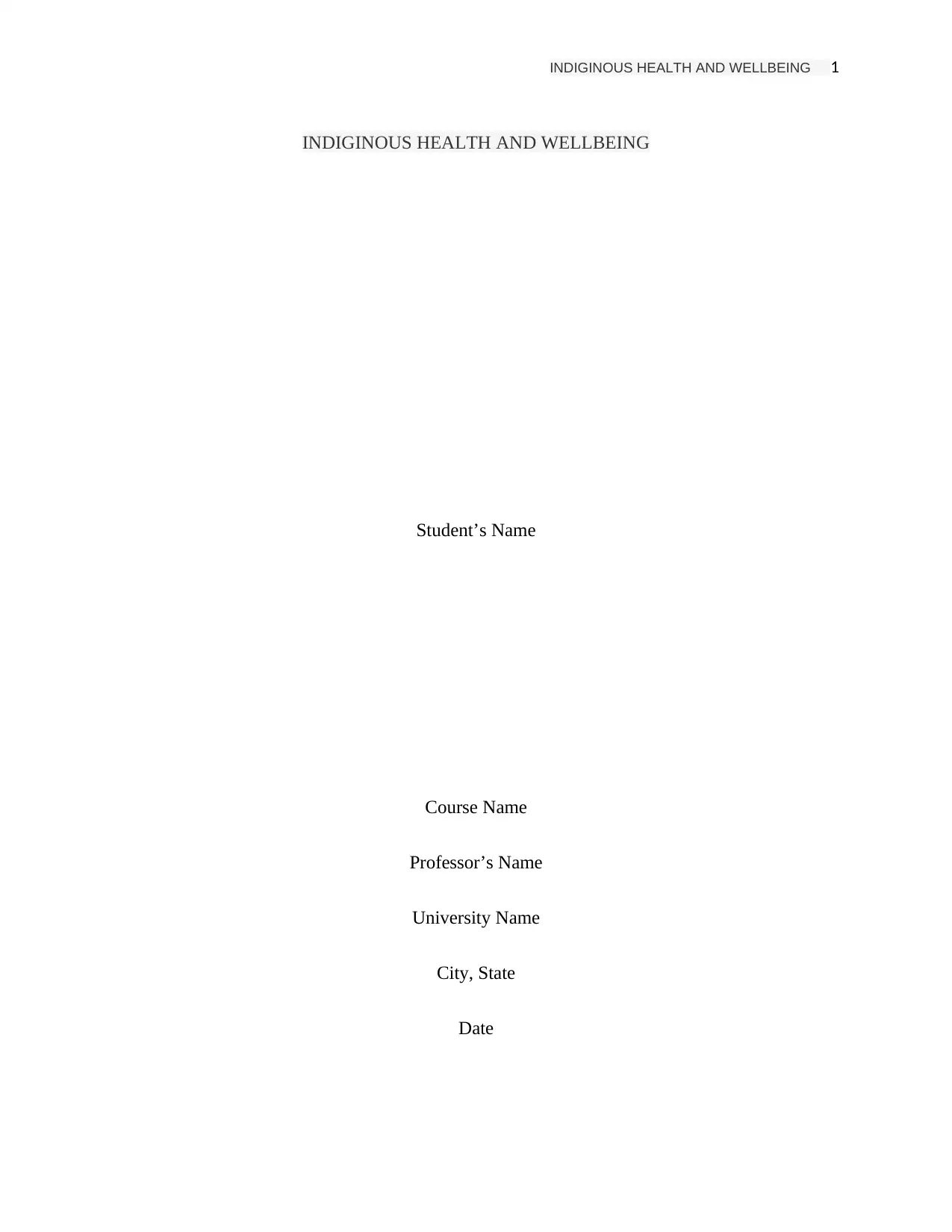
INDIGINOUS HEALTH AND WELLBEING 1
INDIGINOUS HEALTH AND WELLBEING
Student’s Name
Course Name
Professor’s Name
University Name
City, State
Date
INDIGINOUS HEALTH AND WELLBEING
Student’s Name
Course Name
Professor’s Name
University Name
City, State
Date
Secure Best Marks with AI Grader
Need help grading? Try our AI Grader for instant feedback on your assignments.
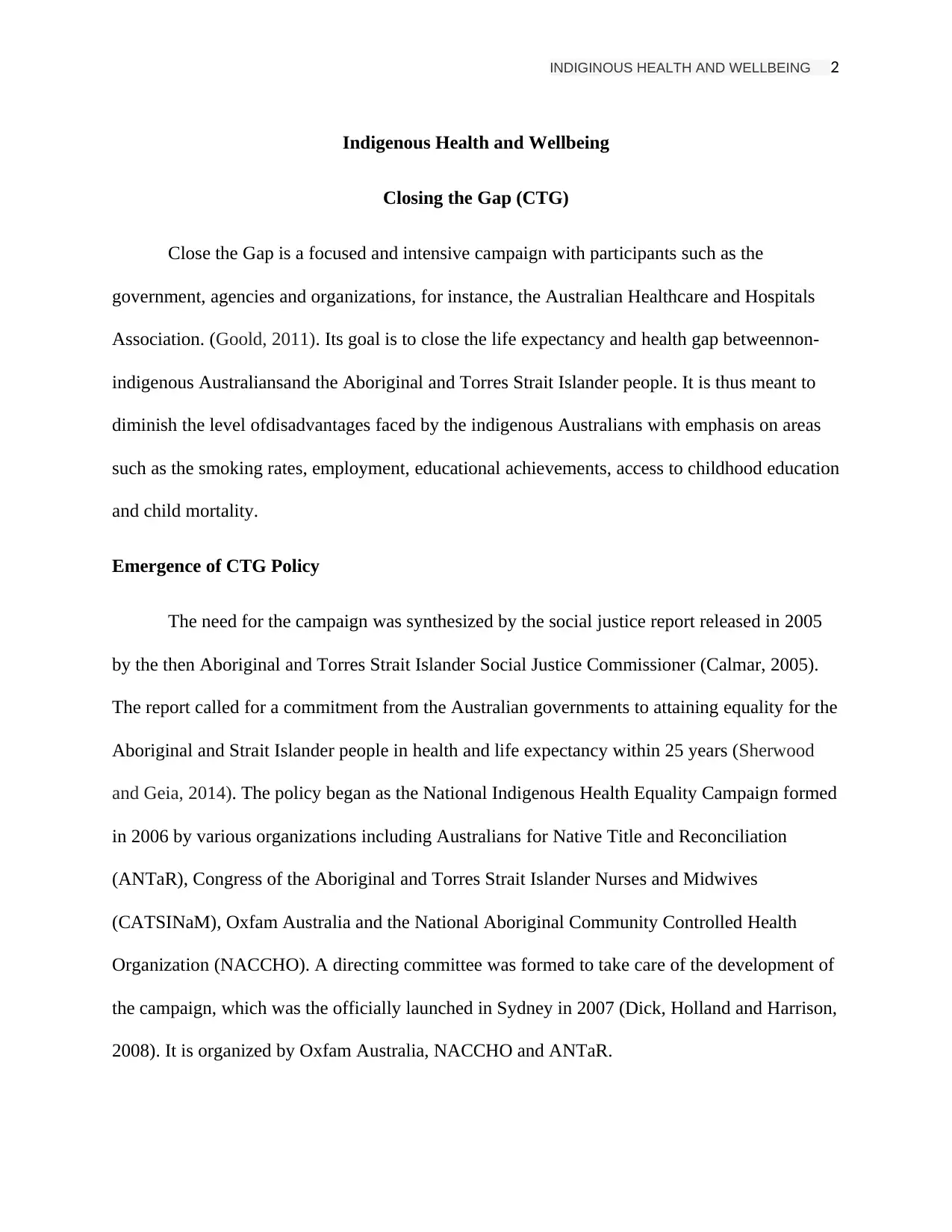
INDIGINOUS HEALTH AND WELLBEING 2
Indigenous Health and Wellbeing
Closing the Gap (CTG)
Close the Gap is a focused and intensive campaign with participants such as the
government, agencies and organizations, for instance, the Australian Healthcare and Hospitals
Association. (Goold, 2011). Its goal is to close the life expectancy and health gap betweennon-
indigenous Australiansand the Aboriginal and Torres Strait Islander people. It is thus meant to
diminish the level ofdisadvantages faced by the indigenous Australians with emphasis on areas
such as the smoking rates, employment, educational achievements, access to childhood education
and child mortality.
Emergence of CTG Policy
The need for the campaign was synthesized by the social justice report released in 2005
by the then Aboriginal and Torres Strait Islander Social Justice Commissioner (Calmar, 2005).
The report called for a commitment from the Australian governments to attaining equality for the
Aboriginal and Strait Islander people in health and life expectancy within 25 years (Sherwood
and Geia, 2014). The policy began as the National Indigenous Health Equality Campaign formed
in 2006 by various organizations including Australians for Native Title and Reconciliation
(ANTaR), Congress of the Aboriginal and Torres Strait Islander Nurses and Midwives
(CATSINaM), Oxfam Australia and the National Aboriginal Community Controlled Health
Organization (NACCHO). A directing committee was formed to take care of the development of
the campaign, which was the officially launched in Sydney in 2007 (Dick, Holland and Harrison,
2008). It is organized by Oxfam Australia, NACCHO and ANTaR.
Indigenous Health and Wellbeing
Closing the Gap (CTG)
Close the Gap is a focused and intensive campaign with participants such as the
government, agencies and organizations, for instance, the Australian Healthcare and Hospitals
Association. (Goold, 2011). Its goal is to close the life expectancy and health gap betweennon-
indigenous Australiansand the Aboriginal and Torres Strait Islander people. It is thus meant to
diminish the level ofdisadvantages faced by the indigenous Australians with emphasis on areas
such as the smoking rates, employment, educational achievements, access to childhood education
and child mortality.
Emergence of CTG Policy
The need for the campaign was synthesized by the social justice report released in 2005
by the then Aboriginal and Torres Strait Islander Social Justice Commissioner (Calmar, 2005).
The report called for a commitment from the Australian governments to attaining equality for the
Aboriginal and Strait Islander people in health and life expectancy within 25 years (Sherwood
and Geia, 2014). The policy began as the National Indigenous Health Equality Campaign formed
in 2006 by various organizations including Australians for Native Title and Reconciliation
(ANTaR), Congress of the Aboriginal and Torres Strait Islander Nurses and Midwives
(CATSINaM), Oxfam Australia and the National Aboriginal Community Controlled Health
Organization (NACCHO). A directing committee was formed to take care of the development of
the campaign, which was the officially launched in Sydney in 2007 (Dick, Holland and Harrison,
2008). It is organized by Oxfam Australia, NACCHO and ANTaR.

INDIGINOUS HEALTH AND WELLBEING 3
Significance of the policy to indigenous Australians’ Health Outcomes
Enhanced accessibility of health care in remote and rural areas in Australia and
particularly by the Aboriginal and Strait Islander people due to increase in the number of
outreach services. The outreach programs are financed via the Commonwealth Department of
Health and purpose to improve the wellbeing of the rural and remote Australians by delivering
crucial health services(Pholi, 2009). These people normally lack access to some health services
such as medical specialists and allied health care.
The policy has led to powerful relationships between organizations such as the
partnership between Australian Health and Hospitals Association (AHHA) and NACCHO
working together to reduce health inequalities in Australia. NACCHO is a representative of
many Aboriginal Community Controlled Health Organizations (ACCHOs) across the country.
This means therefore that the benefits derived from the partnership would be relayed onto the
indigenous Australians whose health and wellness will be enhanced by them.The partnership
makes it possible to harness the strengths of the two associations to reverse the appalling
dissimilaritiesin health between the Aboriginal and Torres Strait Islander people and the non-
indigenous Australians.The agreement allows both the organizations to carry out research on best
health care for the indigenous Australians’ healthiness (Pholi, 2009).
Barriers to Improvement of Indigenous Australian’s Health.
Racism: racialism directed towards the Aboriginal and Torres Strait Islander people
adversely affects their physical and mental health. It causes anxiety, depression as well as other
psychiatric and psychological disorders. Also, it may cause hypertension, heart disease,
premature birth and contribute to low birth weight of new born babies (Paradies, 2008). In health
Significance of the policy to indigenous Australians’ Health Outcomes
Enhanced accessibility of health care in remote and rural areas in Australia and
particularly by the Aboriginal and Strait Islander people due to increase in the number of
outreach services. The outreach programs are financed via the Commonwealth Department of
Health and purpose to improve the wellbeing of the rural and remote Australians by delivering
crucial health services(Pholi, 2009). These people normally lack access to some health services
such as medical specialists and allied health care.
The policy has led to powerful relationships between organizations such as the
partnership between Australian Health and Hospitals Association (AHHA) and NACCHO
working together to reduce health inequalities in Australia. NACCHO is a representative of
many Aboriginal Community Controlled Health Organizations (ACCHOs) across the country.
This means therefore that the benefits derived from the partnership would be relayed onto the
indigenous Australians whose health and wellness will be enhanced by them.The partnership
makes it possible to harness the strengths of the two associations to reverse the appalling
dissimilaritiesin health between the Aboriginal and Torres Strait Islander people and the non-
indigenous Australians.The agreement allows both the organizations to carry out research on best
health care for the indigenous Australians’ healthiness (Pholi, 2009).
Barriers to Improvement of Indigenous Australian’s Health.
Racism: racialism directed towards the Aboriginal and Torres Strait Islander people
adversely affects their physical and mental health. It causes anxiety, depression as well as other
psychiatric and psychological disorders. Also, it may cause hypertension, heart disease,
premature birth and contribute to low birth weight of new born babies (Paradies, 2008). In health
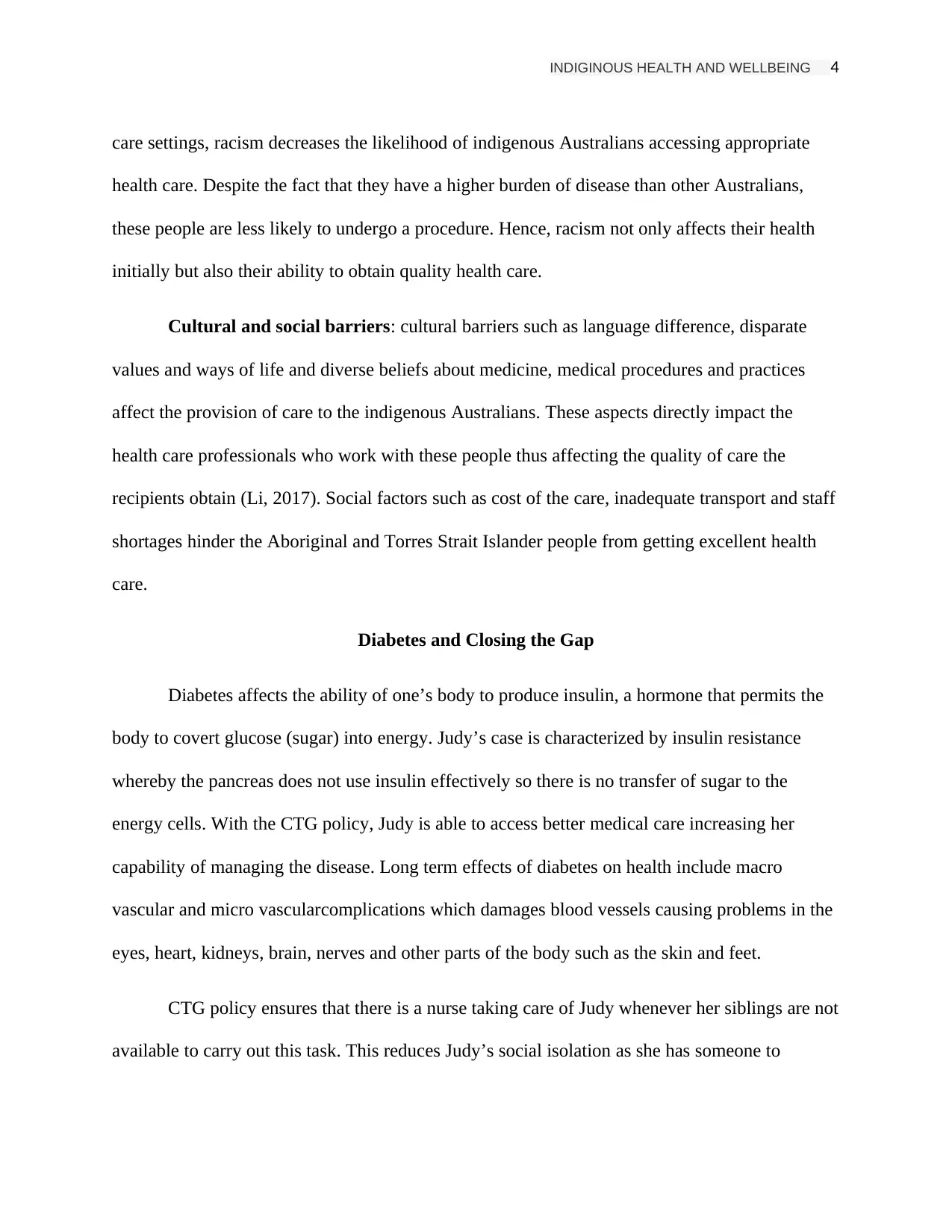
INDIGINOUS HEALTH AND WELLBEING 4
care settings, racism decreases the likelihood of indigenous Australians accessing appropriate
health care. Despite the fact that they have a higher burden of disease than other Australians,
these people are less likely to undergo a procedure. Hence, racism not only affects their health
initially but also their ability to obtain quality health care.
Cultural and social barriers: cultural barriers such as language difference, disparate
values and ways of life and diverse beliefs about medicine, medical procedures and practices
affect the provision of care to the indigenous Australians. These aspects directly impact the
health care professionals who work with these people thus affecting the quality of care the
recipients obtain (Li, 2017). Social factors such as cost of the care, inadequate transport and staff
shortages hinder the Aboriginal and Torres Strait Islander people from getting excellent health
care.
Diabetes and Closing the Gap
Diabetes affects the ability of one’s body to produce insulin, a hormone that permits the
body to covert glucose (sugar) into energy. Judy’s case is characterized by insulin resistance
whereby the pancreas does not use insulin effectively so there is no transfer of sugar to the
energy cells. With the CTG policy, Judy is able to access better medical care increasing her
capability of managing the disease. Long term effects of diabetes on health include macro
vascular and micro vascularcomplications which damages blood vessels causing problems in the
eyes, heart, kidneys, brain, nerves and other parts of the body such as the skin and feet.
CTG policy ensures that there is a nurse taking care of Judy whenever her siblings are not
available to carry out this task. This reduces Judy’s social isolation as she has someone to
care settings, racism decreases the likelihood of indigenous Australians accessing appropriate
health care. Despite the fact that they have a higher burden of disease than other Australians,
these people are less likely to undergo a procedure. Hence, racism not only affects their health
initially but also their ability to obtain quality health care.
Cultural and social barriers: cultural barriers such as language difference, disparate
values and ways of life and diverse beliefs about medicine, medical procedures and practices
affect the provision of care to the indigenous Australians. These aspects directly impact the
health care professionals who work with these people thus affecting the quality of care the
recipients obtain (Li, 2017). Social factors such as cost of the care, inadequate transport and staff
shortages hinder the Aboriginal and Torres Strait Islander people from getting excellent health
care.
Diabetes and Closing the Gap
Diabetes affects the ability of one’s body to produce insulin, a hormone that permits the
body to covert glucose (sugar) into energy. Judy’s case is characterized by insulin resistance
whereby the pancreas does not use insulin effectively so there is no transfer of sugar to the
energy cells. With the CTG policy, Judy is able to access better medical care increasing her
capability of managing the disease. Long term effects of diabetes on health include macro
vascular and micro vascularcomplications which damages blood vessels causing problems in the
eyes, heart, kidneys, brain, nerves and other parts of the body such as the skin and feet.
CTG policy ensures that there is a nurse taking care of Judy whenever her siblings are not
available to carry out this task. This reduces Judy’s social isolation as she has someone to
Secure Best Marks with AI Grader
Need help grading? Try our AI Grader for instant feedback on your assignments.
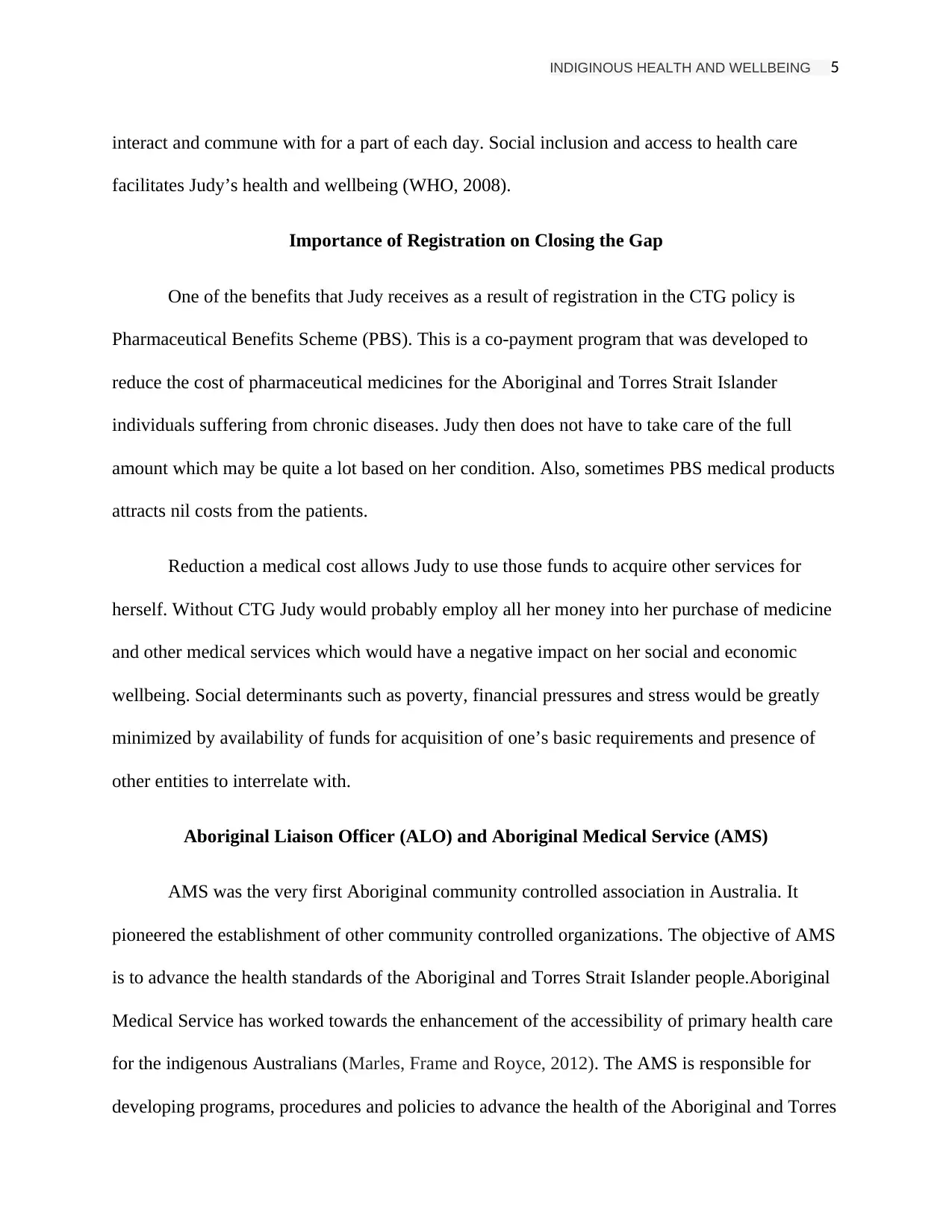
INDIGINOUS HEALTH AND WELLBEING 5
interact and commune with for a part of each day. Social inclusion and access to health care
facilitates Judy’s health and wellbeing (WHO, 2008).
Importance of Registration on Closing the Gap
One of the benefits that Judy receives as a result of registration in the CTG policy is
Pharmaceutical Benefits Scheme (PBS). This is a co-payment program that was developed to
reduce the cost of pharmaceutical medicines for the Aboriginal and Torres Strait Islander
individuals suffering from chronic diseases. Judy then does not have to take care of the full
amount which may be quite a lot based on her condition. Also, sometimes PBS medical products
attracts nil costs from the patients.
Reduction a medical cost allows Judy to use those funds to acquire other services for
herself. Without CTG Judy would probably employ all her money into her purchase of medicine
and other medical services which would have a negative impact on her social and economic
wellbeing. Social determinants such as poverty, financial pressures and stress would be greatly
minimized by availability of funds for acquisition of one’s basic requirements and presence of
other entities to interrelate with.
Aboriginal Liaison Officer (ALO) and Aboriginal Medical Service (AMS)
AMS was the very first Aboriginal community controlled association in Australia. It
pioneered the establishment of other community controlled organizations. The objective of AMS
is to advance the health standards of the Aboriginal and Torres Strait Islander people.Aboriginal
Medical Service has worked towards the enhancement of the accessibility of primary health care
for the indigenous Australians (Marles, Frame and Royce, 2012). The AMS is responsible for
developing programs, procedures and policies to advance the health of the Aboriginal and Torres
interact and commune with for a part of each day. Social inclusion and access to health care
facilitates Judy’s health and wellbeing (WHO, 2008).
Importance of Registration on Closing the Gap
One of the benefits that Judy receives as a result of registration in the CTG policy is
Pharmaceutical Benefits Scheme (PBS). This is a co-payment program that was developed to
reduce the cost of pharmaceutical medicines for the Aboriginal and Torres Strait Islander
individuals suffering from chronic diseases. Judy then does not have to take care of the full
amount which may be quite a lot based on her condition. Also, sometimes PBS medical products
attracts nil costs from the patients.
Reduction a medical cost allows Judy to use those funds to acquire other services for
herself. Without CTG Judy would probably employ all her money into her purchase of medicine
and other medical services which would have a negative impact on her social and economic
wellbeing. Social determinants such as poverty, financial pressures and stress would be greatly
minimized by availability of funds for acquisition of one’s basic requirements and presence of
other entities to interrelate with.
Aboriginal Liaison Officer (ALO) and Aboriginal Medical Service (AMS)
AMS was the very first Aboriginal community controlled association in Australia. It
pioneered the establishment of other community controlled organizations. The objective of AMS
is to advance the health standards of the Aboriginal and Torres Strait Islander people.Aboriginal
Medical Service has worked towards the enhancement of the accessibility of primary health care
for the indigenous Australians (Marles, Frame and Royce, 2012). The AMS is responsible for
developing programs, procedures and policies to advance the health of the Aboriginal and Torres
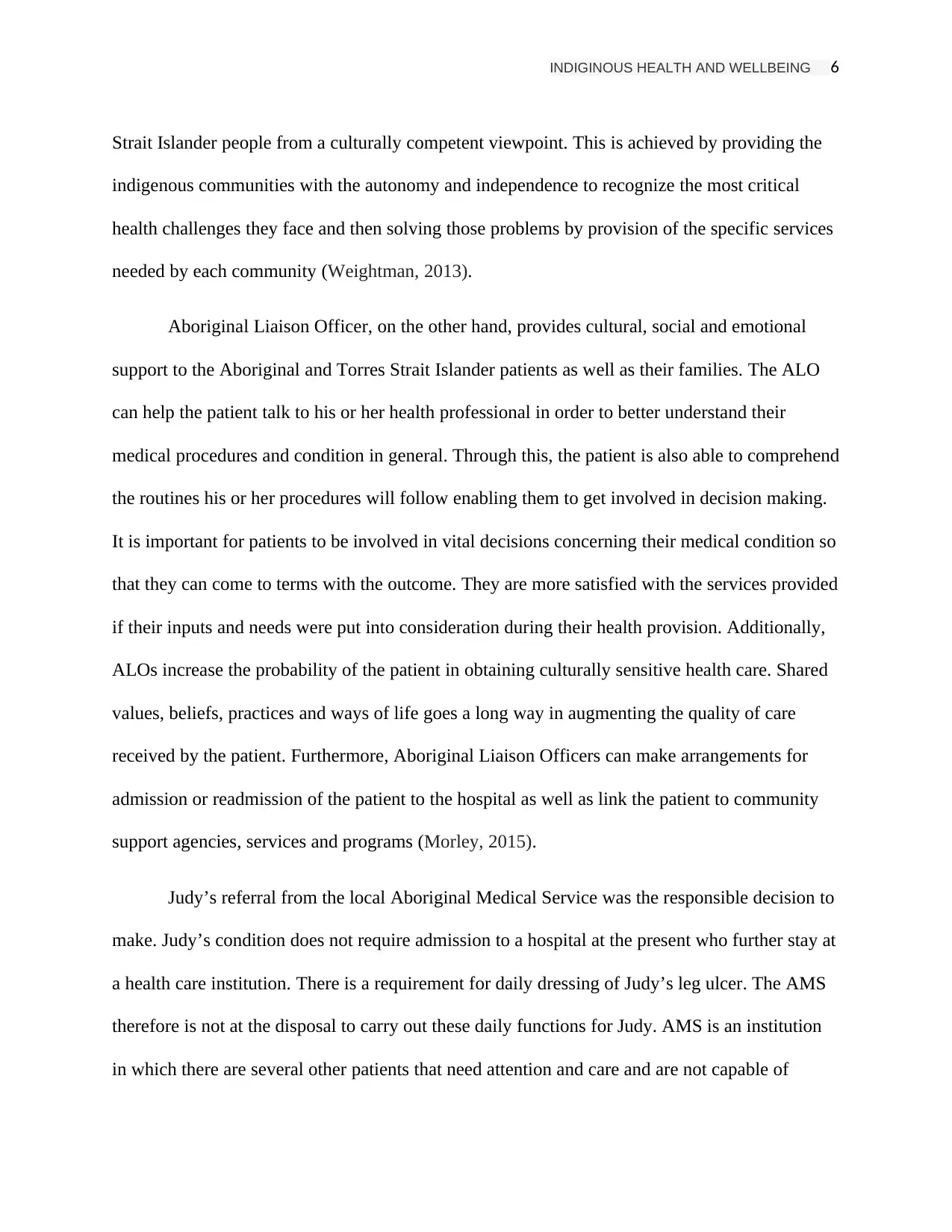
INDIGINOUS HEALTH AND WELLBEING 6
Strait Islander people from a culturally competent viewpoint. This is achieved by providing the
indigenous communities with the autonomy and independence to recognize the most critical
health challenges they face and then solving those problems by provision of the specific services
needed by each community (Weightman, 2013).
Aboriginal Liaison Officer, on the other hand, provides cultural, social and emotional
support to the Aboriginal and Torres Strait Islander patients as well as their families. The ALO
can help the patient talk to his or her health professional in order to better understand their
medical procedures and condition in general. Through this, the patient is also able to comprehend
the routines his or her procedures will follow enabling them to get involved in decision making.
It is important for patients to be involved in vital decisions concerning their medical condition so
that they can come to terms with the outcome. They are more satisfied with the services provided
if their inputs and needs were put into consideration during their health provision. Additionally,
ALOs increase the probability of the patient in obtaining culturally sensitive health care. Shared
values, beliefs, practices and ways of life goes a long way in augmenting the quality of care
received by the patient. Furthermore, Aboriginal Liaison Officers can make arrangements for
admission or readmission of the patient to the hospital as well as link the patient to community
support agencies, services and programs (Morley, 2015).
Judy’s referral from the local Aboriginal Medical Service was the responsible decision to
make. Judy’s condition does not require admission to a hospital at the present who further stay at
a health care institution. There is a requirement for daily dressing of Judy’s leg ulcer. The AMS
therefore is not at the disposal to carry out these daily functions for Judy. AMS is an institution
in which there are several other patients that need attention and care and are not capable of
Strait Islander people from a culturally competent viewpoint. This is achieved by providing the
indigenous communities with the autonomy and independence to recognize the most critical
health challenges they face and then solving those problems by provision of the specific services
needed by each community (Weightman, 2013).
Aboriginal Liaison Officer, on the other hand, provides cultural, social and emotional
support to the Aboriginal and Torres Strait Islander patients as well as their families. The ALO
can help the patient talk to his or her health professional in order to better understand their
medical procedures and condition in general. Through this, the patient is also able to comprehend
the routines his or her procedures will follow enabling them to get involved in decision making.
It is important for patients to be involved in vital decisions concerning their medical condition so
that they can come to terms with the outcome. They are more satisfied with the services provided
if their inputs and needs were put into consideration during their health provision. Additionally,
ALOs increase the probability of the patient in obtaining culturally sensitive health care. Shared
values, beliefs, practices and ways of life goes a long way in augmenting the quality of care
received by the patient. Furthermore, Aboriginal Liaison Officers can make arrangements for
admission or readmission of the patient to the hospital as well as link the patient to community
support agencies, services and programs (Morley, 2015).
Judy’s referral from the local Aboriginal Medical Service was the responsible decision to
make. Judy’s condition does not require admission to a hospital at the present who further stay at
a health care institution. There is a requirement for daily dressing of Judy’s leg ulcer. The AMS
therefore is not at the disposal to carry out these daily functions for Judy. AMS is an institution
in which there are several other patients that need attention and care and are not capable of
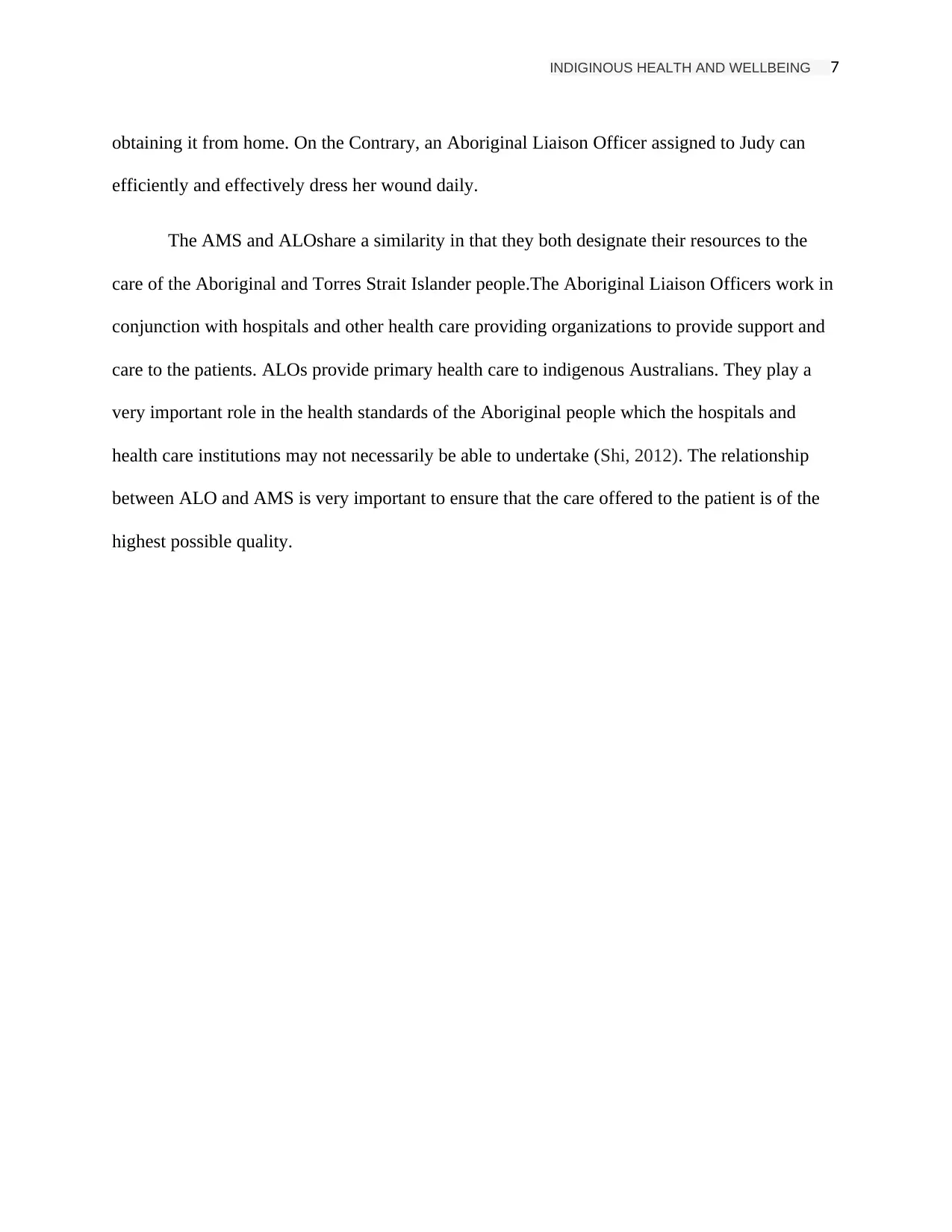
INDIGINOUS HEALTH AND WELLBEING 7
obtaining it from home. On the Contrary, an Aboriginal Liaison Officer assigned to Judy can
efficiently and effectively dress her wound daily.
The AMS and ALOshare a similarity in that they both designate their resources to the
care of the Aboriginal and Torres Strait Islander people.The Aboriginal Liaison Officers work in
conjunction with hospitals and other health care providing organizations to provide support and
care to the patients. ALOs provide primary health care to indigenous Australians. They play a
very important role in the health standards of the Aboriginal people which the hospitals and
health care institutions may not necessarily be able to undertake (Shi, 2012). The relationship
between ALO and AMS is very important to ensure that the care offered to the patient is of the
highest possible quality.
obtaining it from home. On the Contrary, an Aboriginal Liaison Officer assigned to Judy can
efficiently and effectively dress her wound daily.
The AMS and ALOshare a similarity in that they both designate their resources to the
care of the Aboriginal and Torres Strait Islander people.The Aboriginal Liaison Officers work in
conjunction with hospitals and other health care providing organizations to provide support and
care to the patients. ALOs provide primary health care to indigenous Australians. They play a
very important role in the health standards of the Aboriginal people which the hospitals and
health care institutions may not necessarily be able to undertake (Shi, 2012). The relationship
between ALO and AMS is very important to ensure that the care offered to the patient is of the
highest possible quality.
Paraphrase This Document
Need a fresh take? Get an instant paraphrase of this document with our AI Paraphraser
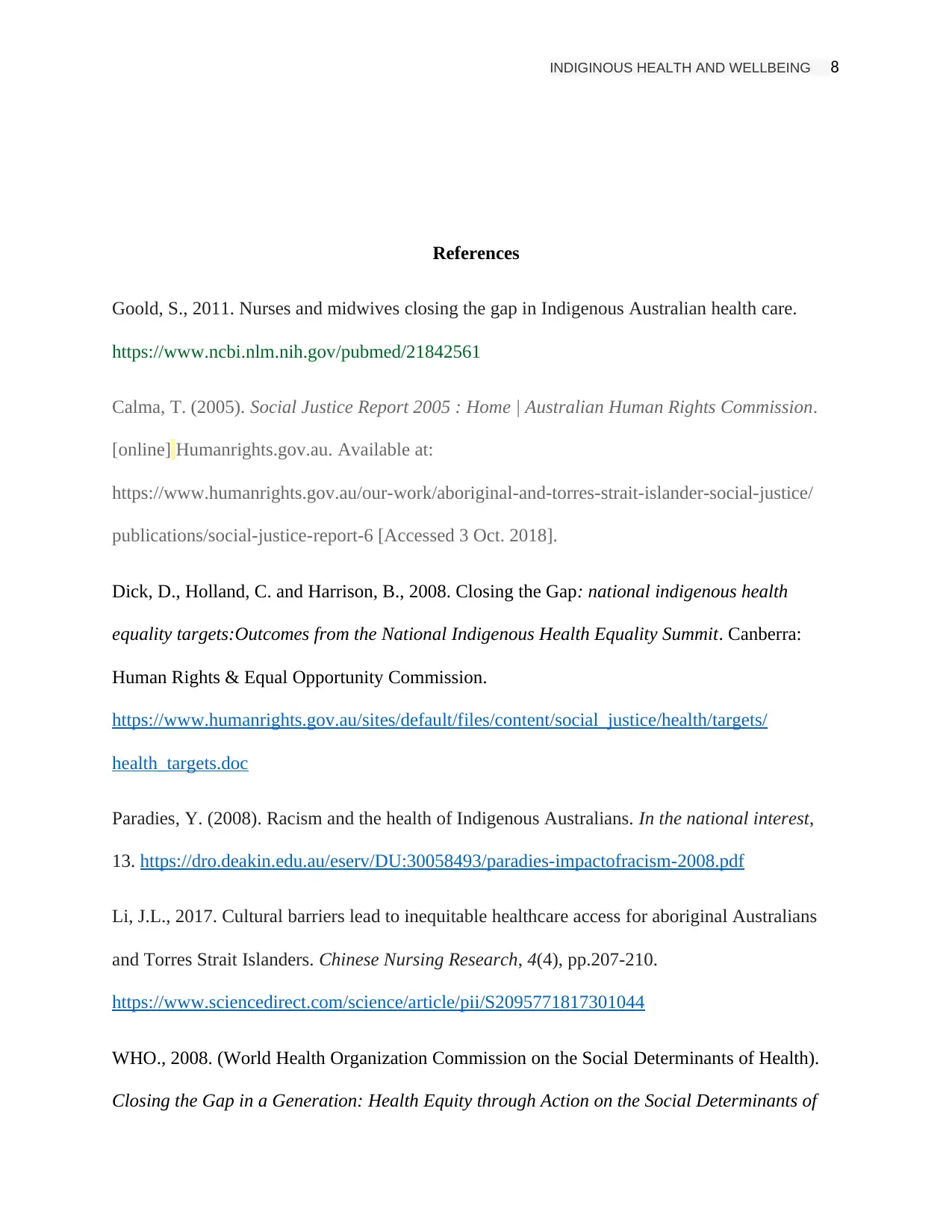
INDIGINOUS HEALTH AND WELLBEING 8
References
Goold, S., 2011. Nurses and midwives closing the gap in Indigenous Australian health care.
https://www.ncbi.nlm.nih.gov/pubmed/21842561
Calma, T. (2005). Social Justice Report 2005 : Home | Australian Human Rights Commission.
[online] Humanrights.gov.au. Available at:
https://www.humanrights.gov.au/our-work/aboriginal-and-torres-strait-islander-social-justice/
publications/social-justice-report-6 [Accessed 3 Oct. 2018].
Dick, D., Holland, C. and Harrison, B., 2008. Closing the Gap: national indigenous health
equality targets:Outcomes from the National Indigenous Health Equality Summit. Canberra:
Human Rights & Equal Opportunity Commission.
https://www.humanrights.gov.au/sites/default/files/content/social_justice/health/targets/
health_targets.doc
Paradies, Y. (2008). Racism and the health of Indigenous Australians. In the national interest,
13. https://dro.deakin.edu.au/eserv/DU:30058493/paradies-impactofracism-2008.pdf
Li, J.L., 2017. Cultural barriers lead to inequitable healthcare access for aboriginal Australians
and Torres Strait Islanders. Chinese Nursing Research, 4(4), pp.207-210.
https://www.sciencedirect.com/science/article/pii/S2095771817301044
WHO., 2008. (World Health Organization Commission on the Social Determinants of Health).
Closing the Gap in a Generation: Health Equity through Action on the Social Determinants of
References
Goold, S., 2011. Nurses and midwives closing the gap in Indigenous Australian health care.
https://www.ncbi.nlm.nih.gov/pubmed/21842561
Calma, T. (2005). Social Justice Report 2005 : Home | Australian Human Rights Commission.
[online] Humanrights.gov.au. Available at:
https://www.humanrights.gov.au/our-work/aboriginal-and-torres-strait-islander-social-justice/
publications/social-justice-report-6 [Accessed 3 Oct. 2018].
Dick, D., Holland, C. and Harrison, B., 2008. Closing the Gap: national indigenous health
equality targets:Outcomes from the National Indigenous Health Equality Summit. Canberra:
Human Rights & Equal Opportunity Commission.
https://www.humanrights.gov.au/sites/default/files/content/social_justice/health/targets/
health_targets.doc
Paradies, Y. (2008). Racism and the health of Indigenous Australians. In the national interest,
13. https://dro.deakin.edu.au/eserv/DU:30058493/paradies-impactofracism-2008.pdf
Li, J.L., 2017. Cultural barriers lead to inequitable healthcare access for aboriginal Australians
and Torres Strait Islanders. Chinese Nursing Research, 4(4), pp.207-210.
https://www.sciencedirect.com/science/article/pii/S2095771817301044
WHO., 2008. (World Health Organization Commission on the Social Determinants of Health).
Closing the Gap in a Generation: Health Equity through Action on the Social Determinants of
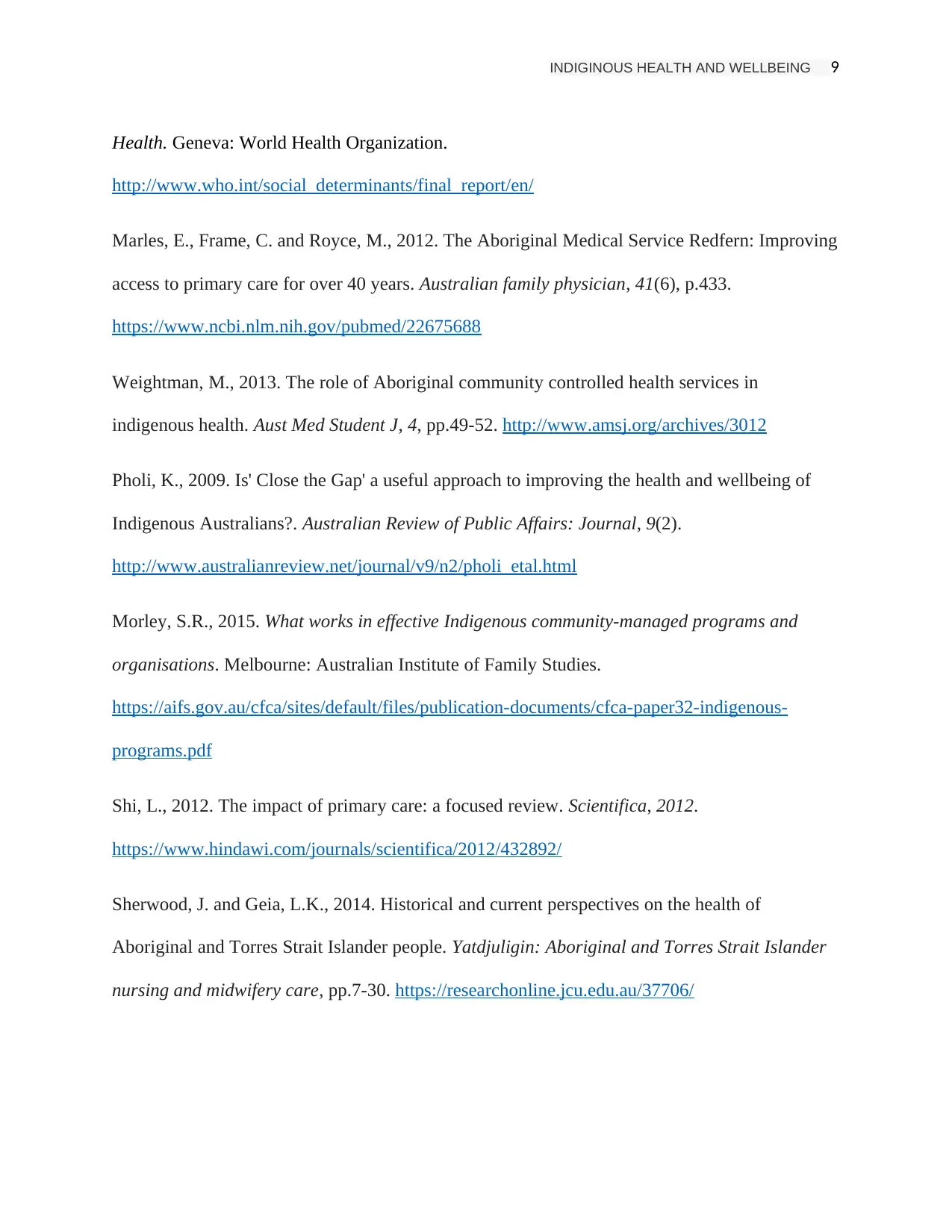
INDIGINOUS HEALTH AND WELLBEING 9
Health. Geneva: World Health Organization.
http://www.who.int/social_determinants/final_report/en/
Marles, E., Frame, C. and Royce, M., 2012. The Aboriginal Medical Service Redfern: Improving
access to primary care for over 40 years. Australian family physician, 41(6), p.433.
https://www.ncbi.nlm.nih.gov/pubmed/22675688
Weightman, M., 2013. The role of Aboriginal community controlled health services in
indigenous health. Aust Med Student J, 4, pp.49-52. http://www.amsj.org/archives/3012
Pholi, K., 2009. Is' Close the Gap' a useful approach to improving the health and wellbeing of
Indigenous Australians?. Australian Review of Public Affairs: Journal, 9(2).
http://www.australianreview.net/journal/v9/n2/pholi_etal.html
Morley, S.R., 2015. What works in effective Indigenous community-managed programs and
organisations. Melbourne: Australian Institute of Family Studies.
https://aifs.gov.au/cfca/sites/default/files/publication-documents/cfca-paper32-indigenous-
programs.pdf
Shi, L., 2012. The impact of primary care: a focused review. Scientifica, 2012.
https://www.hindawi.com/journals/scientifica/2012/432892/
Sherwood, J. and Geia, L.K., 2014. Historical and current perspectives on the health of
Aboriginal and Torres Strait Islander people. Yatdjuligin: Aboriginal and Torres Strait Islander
nursing and midwifery care, pp.7-30. https://researchonline.jcu.edu.au/37706/
Health. Geneva: World Health Organization.
http://www.who.int/social_determinants/final_report/en/
Marles, E., Frame, C. and Royce, M., 2012. The Aboriginal Medical Service Redfern: Improving
access to primary care for over 40 years. Australian family physician, 41(6), p.433.
https://www.ncbi.nlm.nih.gov/pubmed/22675688
Weightman, M., 2013. The role of Aboriginal community controlled health services in
indigenous health. Aust Med Student J, 4, pp.49-52. http://www.amsj.org/archives/3012
Pholi, K., 2009. Is' Close the Gap' a useful approach to improving the health and wellbeing of
Indigenous Australians?. Australian Review of Public Affairs: Journal, 9(2).
http://www.australianreview.net/journal/v9/n2/pholi_etal.html
Morley, S.R., 2015. What works in effective Indigenous community-managed programs and
organisations. Melbourne: Australian Institute of Family Studies.
https://aifs.gov.au/cfca/sites/default/files/publication-documents/cfca-paper32-indigenous-
programs.pdf
Shi, L., 2012. The impact of primary care: a focused review. Scientifica, 2012.
https://www.hindawi.com/journals/scientifica/2012/432892/
Sherwood, J. and Geia, L.K., 2014. Historical and current perspectives on the health of
Aboriginal and Torres Strait Islander people. Yatdjuligin: Aboriginal and Torres Strait Islander
nursing and midwifery care, pp.7-30. https://researchonline.jcu.edu.au/37706/
1 out of 9
Related Documents
Your All-in-One AI-Powered Toolkit for Academic Success.
+13062052269
info@desklib.com
Available 24*7 on WhatsApp / Email
![[object Object]](/_next/static/media/star-bottom.7253800d.svg)
Unlock your academic potential
© 2024 | Zucol Services PVT LTD | All rights reserved.




